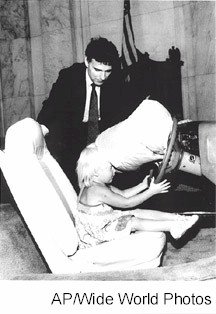Only Smart Air Bag Mandate is No Mandate at All

By the time you receive this newsletter, the National Highway Traffic Safety Administration (NHTSA) either will have issued its “smart” air bag mandate, or will be on the verge of doing so. The rule will supposedly bring us a new generation of air bags that, in case of collision, will tailor their deployment to the characteristics of both the front seat occupant and the collision itself. What does this mean? In plain English, with luck, these smart air bags won’t kill kids the way the first generation of mandated air bags has.
Will this ambition be realized? Maybe, maybe not. The main reason we shouldn’t get our hopes up is simple. The agency that’s bringing us the smart air bag mandate is the same agency that produced the original air bag fiasco.
The original air bag mandate did save lives overall, and it continues to do so. But it also did some surprisingly unexpected things as well:
· Mandated air bags have turned out to pose a hazard to children in the front seats of cars, killing at least 86, many in low-speed accidents that should have been survivable. When it comes to kids 12 and under, air bags offer no net benefit; rather, they are an actual danger.
· In terms of reducing fatalities, air bags have proved to be less than half as effective as NHTSA had projected.
· The mandate reversed the very rationale which had originally produced it. In the late 1970s, NHTSA had told us that air bags were necessary to protect people because seat belt use was so low. But when the hazards of air bags became evident in the 1990s, NHTSA began advising us to wear our seat belts or else the air bags would get us.
The basic flaw in the air bag mandate is the notion that it’s government’s business to force us to protect ourselves. But that flaw is an ethical issue, and ethics are largely banished from today’s technocratic regulatory debates. (As an ethical aside, consider that NHTSA’s new-car fuel economy program very likely kills at least as many people as are saved by air bags.) But even at the technocratic level, the air bag mandate has yet another basic flaw—it’s based on practically no real-world testing whatsoever.
Which mandate are we referring to? Both of them! When the original mandate was issued, NHTSA had before it a large number of lab tests and crash simulations, but it had practically no data on the devices from actual cars on actual roads. In fact, the real-world data that NHTSA did have were counterindicative, with more fatalities than would have been expected from conventional cars. In a 1979 court case (in which yours truly was involved), a federal court upheld NHTSA’s decision to proceed in the face of such data. But the court noted that this meant that NHTSA had to “monitor closely” the road experience of air bags once they went into widespread use.
How good a monitoring job did NHTSA do? The best answer can be found in a 1991 agency memorandum, written after a meeting with carmakers to discuss the handful of air bag deaths that had come to light at that time. The memo notes, “NHTSA’s concern that the potential for bad press on these few cases could cause a lot of harm to the public’s positive perception and receptiveness to air bags.” In short, the safety agency’s primary concern wasn’t alerting the public to this newly-discovered risk; instead, its first priority was spin control.
Now NHTSA is bringing us a new generation of mandated air bags. How much real-world data on these devices does it have this time around? Zero.
One might think that NHTSA would learn from experience. Even without real-world data, one would figure that this time a chastened but wiser agency would insist on even more extensive testing than the last time.
But there are limits to just what can be learned without real world data. Consider the fact that, since 1996, at least three million cars have been recalled due to air bag-related defects. At least half of those were due to the sorts of problems that simulations and pre-production testing are unlikely to find: environmental stress to sensor wiring (300,000 Fords recalled); corrosion from moisture entering the air bag module (26,000 Saabs); module corrosion from road salt entering the interior (263,000 Chryslers); durability problems (55,000 Audis); malfunctions from spilled drinks (625,000 Toyotas and Geos).
Spilled drinks and environmental stress are nothing new, but their effects on air bag technology apparently are. Yet if the first generation of air bags proved so unpredictably vulnerable to these factors, imagine what will happen to the far more complex technology involved in smart air bags.
One widespread claim made these days is that the auto industry sold us on the false image of air bags as soft, billowing cushions that would protect us all, especially our children. I remember those ads from a decade ago. But the notion of air bags as a cure-all originated long before that, and its momentum came not from an industry marketing campaign but from a federal regulation and those who pushed for it. Long before the industry’s ads, Joan Claybrook, head of NHTSA during the Carter-era air bag rulemaking, declared that air bags “fit all different sizes and types of people, from little children up to…very large males.” “Air bags work beautifully,” she explained, “and they work automatically and…that gives you more freedom than being forced to wear a seat belt.”
As for Ralph Nader, the photo here, from a 1977 press conference endorsing air bags, says it all.

Sam Kazman ([email protected]) is general counsel at the Competitive Enterprise Institute.